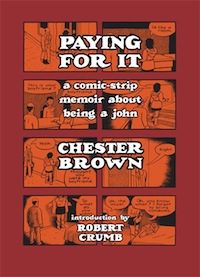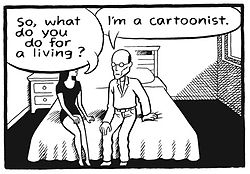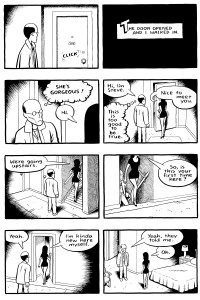
Chester Brown didn’t want his book to be called Paying for It, but as the title of a “comic strip memoir about being a john” it seems pretty fitting. Not only for its obvious sense, in which “it” is clearly “sex,” but also in its other, metaphorical sense of paying the price for an apparently blameworthy act.
But if “it” is the standard coy replacement for “sex,” sex is no longer the unmentionable act it once was. Instead, “paying for it” as a whole is taboo. We may talk about it enough, but very few people are willing to come forward and admit they’ve done it.
 Brown is one of the few public figures to take on this stigma. His carefully drawn memoir tracks his experiences in intimate detail, beginning with his rejection of romantic love and following his encounters with prostitutes from the first right up to the present day. The book gives a sensitive portrayal of the world of prostitution, and it also has something to say: it grapples with the moral, emotional, and theoretical arguments against prostitution. It embraces the “unspeakable” for almost 300 pages. Brown rejects the guilty aspect of the title; the book is an affirmation of prostitution, and the fact that he has put both his name and his photo to the book shows he is not ashamed of his story.
Brown is one of the few public figures to take on this stigma. His carefully drawn memoir tracks his experiences in intimate detail, beginning with his rejection of romantic love and following his encounters with prostitutes from the first right up to the present day. The book gives a sensitive portrayal of the world of prostitution, and it also has something to say: it grapples with the moral, emotional, and theoretical arguments against prostitution. It embraces the “unspeakable” for almost 300 pages. Brown rejects the guilty aspect of the title; the book is an affirmation of prostitution, and the fact that he has put both his name and his photo to the book shows he is not ashamed of his story.
“Buying sexual services is a violence committed against prostituted individuals.”
In coming out of the john’s closet, Brown could not have picked a worse time.
On its publication in 2011, the book arrived during a growing global push towards the abolition of prostitution. Although in Canada, Brown’s homeland, the Supreme Court has recently ruled that laws including the prohibition of brothels and public communication with clients are too sweeping, in France and New York, among others, legislation and policymakers are increasingly figuring the prostitute as victim, and the client as criminal, in paid sexual encounters. In other words, Brown and those like him have become the real enemy. Stamp out the demand and you stamp out the supply—or so the thought goes.
This is otherwise known as the “Nordic Model”: following Sweden’s lead, the Equality Now campaign in the US and the European Women’s Lobby in Europe are also calling for states to decriminalize “prostituted individuals” while penalizing the demand for commercial sex. This is almost a reality in France where ministers have backed a bill that, if passed by the Senate, will penalise clients through heavy fines and re-education programs. In New York, special courts have been set up to ‘save’ prostitutes. For Brown to take the stand as a client at this time is then to face severe moral opprobrium. One of the central tenets of the abolitionist movement can be found on the French Socialist Party website: “Buying sexual services is a violence committed against prostituted individuals.”
The sublimation of clients as people, and of prostitutes as individuals with agency, is just one of the problems with the above sentence, contributing as it does to a culture which degrades women who choose sex work and demeans men who pay them for it. Brown doesn’t let these sorts of accusations slide. In the extensive appendices (there are 23), he tackles everything from “Drugs” and “Violence” to “Power” and “Self Respect.” These are complex and charged issues, ones not easily settled. Brown does a good job: through cartoons, anecdotes, quotes from an extensive reading list, and responses to feminist theorists, he sets out a clear and sustained argument for decriminalization (no laws, no one getting arrested—as opposed to legalisation, which would mean laws regulating prostitution). He dismisses arguments with a gently articulated ease sometimes bordering on flippancy. “Paid sex is usually pretty much the same as unpaid sex,” he argues, and real violence against prostitutes would be better tackled by full decriminalization. On the subject of choice, he says:
If a woman has the right to choose to have an abortion, she should also have the right to choose to have sex for money. It’s her body, it’s her right. […] That doesn’t mean the choices are easy, but a difficult choice is still a choice.
Brown uses “choice,” but it’s perhaps better dealt with as an issue of agency; women as agents directing their lives, rather than passive victims. The latter might be applicable to sex slaves, but it is important to distinguish these women from those who have chosen sex work through their own free will, a distinction most abolitionists refuse to make (the Trafficking Court in New York saves all women from “their own poor choices”[1]). This difference is dealt with in the appendices, and the majority of women Brown visits are Canadians who have chosen sex work. Brown argues that there is no significant consumer demand for the sex slaves that are the focus of anti-prostitution legislation, and that laws penalizing clients are “misplacing the blame.”
The Bad Guys?
In the eyes of the abolitionists, however, Brown remains an evil exploiter of women. And who is this heartless criminal? Memoir indeed, the book gives us Brown at both his strongest and most vulnerable; bald, emaciated, eyes hidden behind blank spectacles, we see him engaging in heated debate and many, many sexual encounters.
From the deeply personal we are encouraged to extrapolate the general: “I’ll bet I’m close to what the typical john is like,” he says to an ex. “I’ll bet a lot of johns are mild-mannered introverts—guys who would never even consider assaulting anyone.” His ex remains doubtful, and as readers we might be inclined to believe that Brown is simply one of the “atypical examples you hear about in the media,” albeit more endearing than the customary sociopaths and rapists. He is at his best when acknowledging his own subjectivity, providing an alternative to those mass-media representations while recognizing that his is not the only experience: “I think it might be possible that paying for sex could lead a man to greater emotional sensitivity, at least in some johns.”

Brown’s mild-mannered, emotionally sensitive men are incompatible with the cliché of the socially deviant client. These men would be amiable and articulate if dragged in front of the law, and in no need of the re-education programs of the John Schools that many arrested clients are forced to attend in the UK and North America. These are programs that try to force johns to see the error of their ways, to come back into the fold of “normal,” socialised sexuality. Already criticized for a lack of clear goals and the impossibility of defining success, they can also be seen, as Brown’s book shows, as inappropriate in their very nature of trying to tackle an entire group of people, to create a blanket cure for all clients. Melissa, an ex-sex worker writing for xoJane, sums up the problem with trying to place clients under one umbrella:
The guys I met while selling sex were grown up versions of the boys I went to high school with. I met all kinds of guys—young men, old men, sad men, clever men. […] Just as there’s no one typical sex worker, there’s no typical “John.”
And, it might be added, there is no typical type of sex work (street-walking, escorting, brothels—their similarities end after the selling-sex part) or way of having sex, either.
“Paid sex is pretty much the same as unpaid sex”
Illustrating his argument that “paid sex is pretty much the same as unpaid sex,” the sex that Brown has in the book is fairly bog-standard. We see Brown, straight-lipped, rutting over nubile young bodies, the mundane thoughts that cross his mind (“Should I take my glasses off?”) hovering over them. There are awkward moments of erectile dysfunction and premature ejaculation, and even moments of comedy. (One young prostitute watches TV through their entire session.) It is an admirably frank portrayal, but sometimes the honesty slips into the uncomfortable. When Brown confesses to being turned on by the prostitute who says “ow” during sex, we wince, and his blunt assessments of the women he sleeps with (he deems a 28-year-old too old) threaten to turn him into the sleazy creep in need of a John School education.
His writing of customer reviews is particularly unsettling. He uses one of the many websites that exist worldwide for clients to rate and recount their experiences with prostitutes—sort of like an X-rated Amazon. When Brown confesses to getting the best blowjob of his life but then says he’s going to give the woman a bad review because she covered her face during sex, readers may be repelled by his lack of empathy. The callous and dehumanizing nature of review websites makes them a controversial subject for sex workers and feminists alike; particularly gruesome excerpts from reviews are being used as a campaign tool for abolition in France,[2] while sex workers themselves are divided over whether they appreciate the publicity or dislike the invasion of privacy.[3]
Brown covers this briefly in his footnotes. Indeed, almost every uncomfortable moment is addressed. (He explains that he looked for women under 28 to increase his chances of finding someone attractive without the aid of photos, and assesses the possibility of whether the women with foreign accents are sex slaves or not – he decides not) These brief notes might not be enough to soothe some readers’ misgivings, but it is this constant self-assessment and reflexivity that saves Brown from the “sex creep” moniker, and makes his book more than simply a dramatized I-pay-for-sex diary. Which it could easily have been.
Meeting the Women: Anne, Carla, Jenna, Gwendolyn, Jolene, Nancy, Edith…
Rather than focusing exclusively on the sexual exploits and soul-searching of its protagonist, Brown’s book is equally interested in the prostitutes themselves. Chapters carry the women’s names as titles, highlighting their individualized importance. Gwendolyn, Jolene, Denise: these are all fake names. Brown’s sensitivity to the privacy of his “characters” is also evident in the anonymity he grants by obscuring faces (with speech bubbles, by placing them out of shot or with their backs turned), and by generalizing hair color and race. While this might threaten to whitewash them all into one white, dark-haired woman, Brown’s inclusion of their stories, opinions, and voices means he delivers a multi-faceted view of prostitutes just as he does of johns; Larissa began by stripping, Nancy preferred being a masseuse, Edith doesn’t consider herself a prostitute at all: “You’re paying me to spend TIME with you, NOT to have sex with you. If I have sex with you during the time you’ve paid for it’s because I choose to, not because you’re paying me to,” she admonishes a prone and naked Brown.
Though Edith’s claim might be slightly self-deluding (Brown asks of the other guys, “were there any you didn’t have sex with?” and Edith is forced to answer, after a bathetic pause, “No.”), it does capture something of the quality of these encounters: Brown builds relationships with the women through pillow talk almost as extensive as the sex scenes themselves.
If Brown leaves his first prostitute feeling “exhilarated and transformed,” it is also a positive experience for her: “You’re an angel—thanks so much. […] I enjoyed meeting you.” Abolitionists would argue that this is a distorted image of equality through commercial exchange,[4] but here Brown shows rather than dictates his argument. He paints intimate portraits of two consenting adults exchanging opinions, stories, sex, and yes, money. In this way, the portraits seem to support the book’s overriding idea that “prostitution is just a form of dating”—an equal exchange with mutual benefits. They remind us that the context for these encounters is Brown’s rejection of the institution of monogamy and “romantic love.”
Love and Sex: Work
This is the other side to whatever banner Brown is waving, the one that didn’t make it into the title; if the book is about supporting prostitution, it is also about undermining our ideas of romance. Monogamy and love are continually under discussion. Brown’s professed opinion is: “Romantic love is bullshit.”
This might actually be the most subversive part of Brown’s book—he is not just seeing prostitutes “on the side,” or because he’s going through a “dry spell,” but has actively chosen them as his only source of sexual fulfilment while absconding from “normal” sexual relations. “Normal” crops up continually in the comic. It’s what Brown wants prostitution to be: not just decriminalised, but socially acceptable, unremarkable.
On this score, Brown doesn’t fully convince. In an appendix called “The Normalization of Prostitution” he describes a bizarre sexual utopia in which “most people” engage in paid sexual encounters, and “most people” find it acceptable to do so. What he’s talking about here, though, is not just the normalization of prostitution; it is the extinction of the sex worker. When he says, “Romantic love is work. Call me lazy, but I don’t want to do the work,” he fails to recognise that his chosen alternative is no different, that for most prostitutes sex is work; this is what they do for a living.
If sex can be considered work, then like in other jobs, sex workers should have rights, protection, recognition, the possibility of unionization. It is for these benefits that groups such as STRASS (sex workers union) in Paris and SWOP (Sex Workers Outreach Project) in the US are campaigning.
But if Brown diverges from dominant anti-abolitionist thought here, he is implicitly in agreement on one thing: that the stigma surrounding prostitution should be lifted. This stigma silences sex workers as effectively as its accompanying taboo does johns, only the consequences of sex workers’ marginalization are much more severe than the johns’.
…
Brown’s book, by bringing these hidden stories out into the open and showing some of the realities for both clients and sex workers alike, goes some way to lifting the stigma from the shadowy world of prostitution. Rather than display a patronizing acceptance of “prostituted women,” Brown leads his readers along the complicated path towards a genuine support of prostitution. He rejects pity and shaming as appropriate responses, and shows why prostitution is normal, or why it should be seen as such.
Perhaps this, then, is the real reason for Brown’s discomfort with his book’s title: there should be no double meaning there, no coyness or embarrassment or sly wink to the audience. It just doesn’t fit a book that is so frank in intention and representation. Paying for it should be just that: paying for it.




